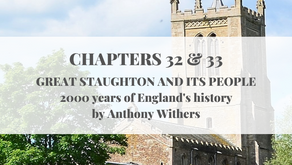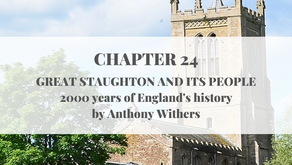GREAT STAUGHTON AND ITS PEOPLE
2000 years of England's history
by Anthony Withers
This book is about the remarkable people from this modest Huntingdonshire village who, over the past two millennia of England’s history, exercised power and influence both locally and on the national stage. The book gives a detailed biography of each of these characters, setting their lives in the wider context of English history from the time of the Romans to the present day.
READ NOW. New chapters being released weekly.
An introduction to the village and the book
About Great Staughton
The ideal place to begin a gentle exploration of Great Staughton is the Highway (aka the B645), for centuries the commercial heart of the village. Coming west from St Neots, you will cross Staughton bridge and continue up the Highway, passing on the right the sundial with its mysterious inscription on its rear face and the White Hart, a coaching inn dating from the time of Oliver Cromwell. The White Hart is one of two pubs in the village. Continuing on the main road to the other end of the village, you arrive at the second of the village pubs, the Snooty Tavern, opposite which is the official car park. Both pubs serve food.
The next objective is to follow in the footsteps of John Leland in 1540, taking the Causeway down to the Town, the oldest and most historic part of the village. Cross the Town bridge and you are now in front of the church, and to the right, Place House. A tour of the church of St Andrew is a must. It is the repository of village history. Admire the magnificent double monument to Sir James Dyer and his wife, his nephew Sir Richard Dyer and his wife. Nearby is the impressive tomb of George Wauton. Numerous plaques and brasses tell their stories of the great and the good of Staughton's history.
Tucked away behind the church is Staughton House in whose spacious grounds John Howey built his 15” gauge railway.
Worth a visit is the moat built by Sir Adam de Creting in the 1270s. It is walkable from the village but a better plan is to drive to Little Staughton church from where it is a bracing 10 minute walk along the ridge (good views) to admire what is shown on old maps as Cretingsbury.
Great Staughton is a mere 3 miles from the charming market town of Kimbolton. It was in its castle (now a school) that Catherine of Aragon was imprisoned and ultimately died in 1536. Unfortunately, the castle is not generally open to the public.
Also on the doorstep, two miles away in Perry, is Grafham Water, a centre for sailing, fishing, cycling, walking and generally having a good time.
In 1982, the village took part in a county-wide sports competition which Great Staughton eventually won. To celebrate, t-shirts were produced emblazoned with the slogan: ‘Great Staughton - Great Little Village.’ Enough said!
About the book
A series of articles entitled ‘Snippets of local history’ which appeared in Life, our excellent local magazine was the origin of the book. These articles became the foundation stones of the extensive biographies of the extraordinary people who have played a role in the reigns of virtually every English monarch over the past 2000 years. The title of the book explains all:
GREAT STAUGHTON and ITS PEOPLE
How a Huntingdonshire village left its mark on England's history
The book will be uploaded chapter by chapter over the coming weeks, with a separate brief introduction to each chapter.
We don't know the name of the first person to leave his mark on village history. He probably came from a Romano-Belgic tribe and he built a substantial villa in the village in the third century AD. The villa was excavated in 1958-9 and the archaeological findings reveal an astonishing story of the influence Rome wielded in this corner of Britannia.
This is just the start of Great Staughton’s history. After the Romans came the Anglo-Saxons. The will of a 10th century nobleman, Ælfhelm Polga, as well as containing the first documentary reference to the village also provides a vivid description of the life and times of a nobleman who lived just five decades after Æthelstan united the diverse Anglo-Saxon kingdoms into one country - England.
The village and its church appear in the Domesday Book and are now part of the estate of its new Norman overlord. The life and death of Sir Adam de Creting, loyal soldier of Edward I and builder of the great moat that became Cretingsbury, are recorded in numerous contemporary documents, including an account of his death in Gascony.
The Wauton/Walton family dominated village and national life for nearly four centuries. George Wauton did his bit against the Armada, whilst his relative Valentine Walton achieved notoriety as one of the ‘killers of the King.’ His contemporary, John Gaule enters the history books by crushing the Witch Finder General, Matthew Hopkins.
There are fabulous tales of derring-do. The wonderful account of Richard Walter, recording the triumph and tragedy of Captain Anson’s Voyage Round the World, has been an inspiration to writers as diverse as Joseph Conrad and Patrick O’Brian. It’s not just Staughton men who blazed a trail through England’s history. Fanny Duberly, formidable woman of Staughton, swept through the Crimean Campaign with her husband and her account of the Charge of the Light Brigade and the Siege of Sebastopol make thrilling reading.
A slightly less edifying story is told in the scandal that rocked polite society in Georgian London with the trial in 1792 of Major-General John Gunning, found guilty of adultery with Rebecca, wife of the highly respectable supplier of army uniforms, James Duberly. Five years later, James Duberly purchased the Gaynes Hall estate, thus establishing the family in Great Staughton.
In the Huntingdon Records Office is a beautifully bound six-hundred-page handwritten volume; its pages are filled with poetry, anecdotes, newspaper reports, philosophical musings and scientific descriptions of nature. Who compiled this book and when? Why was it written? This two-centuries old whodunnit is uncovered, layer by layer, in a forensic detailed analysis.
John Howey built his ambitious Staughton Manor railway in the grounds of Staughton Manor before going on fifteen years later to found the Romney Hythe and Dymchurch Railway. In between, this chapter also tells the amazing story of his mid-air escape from his stricken Sopwith fighter plane in the war-torn skies of Belgium during the First World War.
These are just a few of the people who brought fame to our village. There are others like Oliver Leder, friend of Thomas Cromwell, and a key player in Henry VIII’s court; James Dyer who introduced the concept of legal precedents into English Common Law. Rev. H.B. Wilson took on John Henry Newman, forcing the latter into the arms of the Catholic Church and later sainthood.
Great Staughton is today a modest village in Huntingdonshire (actually Cambridgeshire since 1974), but what it lacks in stature, it more than makes up for in the rich and varied characters who have peopled its history over the past two millennia.
About the author
Anthony Withers was born in Prestwich, Manchester in 1945 and was educated at Stand Grammar School and Queen Mary, University of London where he studied Modern Languages.
After some years working in industry, he founded Anglia Translations Ltd in Huntingdon, which he ran until his retirement.
He has a son and daughter and five grandchildren.
Feedback
… is welcome: your views, comments, suggestions. Contact Anthony Withers on:























































